- TOP
- Search Criteria
- Early Spring Beauties! 4 Spots to See Plum Blossoms in Tokyo

STORY
Early Spring Beauties! 4 Spots to See Plum Blossoms in Tokyo (and 3 Plum Snacks to Go With Them)
What is there to do in Japan in February? The weather can be quite cold and the New Year celebrations are well in the past. However this is not a dead month! If you're here during this period you can participate in the Setsubun festival, or stock up on chocolate for Japanese Valentine's day, not to mention enjoying some delicious winter dishes like oden or nabe.
Few might know that this is also the season for ume! Known as Japanese plum or Japanese apricot in English, these trees come in many varieties that bloom around February producing gorgeous flowers of many colors like white, pink, red, and yellow. Their beauty is comparable to that of the more popular cherry blossoms, and there are many places where you can enjoy them.
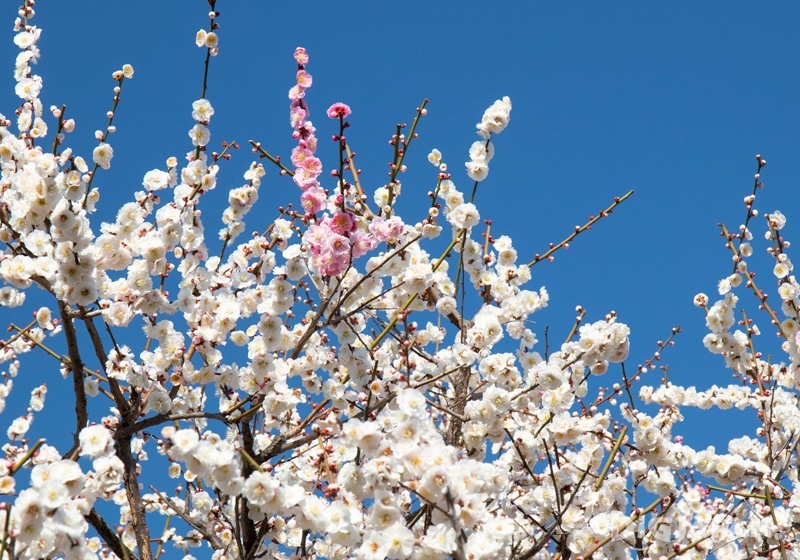
For this article I put together my top four personal recommendations for plum blossom spots in Tokyo. I also went to my trusty local supermarket and picked up a few special ume-flavored snacks that are only available in this period!
Plum blossoms in Tokyo usually bloom from mid-February to mid-March.

Kameido Tenjin is a shrine tucked away in a quiet and picturesque area of Koto Ward. Its grounds are like a Japanese garden, with a central pond surrounded by walkways where visitors can stroll. You can watch big carps lazily swimming in the pond and many turtles (the "kame" in Kameido means "turtle" in Japanese) chilling on its shores. The 300 plum trees planted here are a stunning spectacle in February.
Kameido Tenjin holds a plum blossom festival from early February to early March, with food stalls scattered around the grounds.
(the 2021 festival was cancelled but you can still visit the shrine)
Note: Don't miss the nearby Kameido Umeyashiki, a facility named after an estate that was popular for its plum trees in the Edo Period. The Umeyashiki was even depicted in and ukiyo-e print by Hiroshige! It is now a tourist information and commercial facility where you can find the best of Kameido and Koto Ward.
Address: 3-6-1 Kameido, Koto-ku, Tokyo (MAP)
Access: 15 min. walk from Kameido Station (North Exit) on the JR Sobu Line / 15 min. walk from Kinshicho Station (North Exit) on the JR Sobu Line and Tokyo Metro Hanzomon Line
Website (Japanese-only): http://kameidotenjin.or.jp/
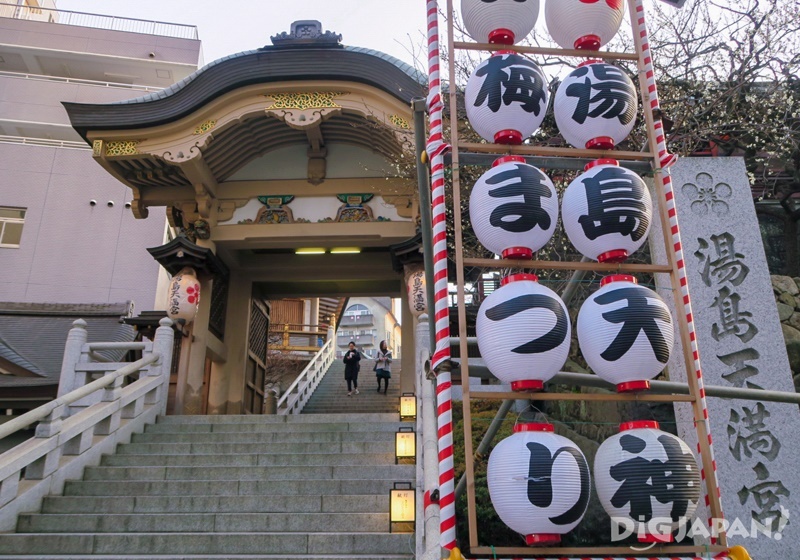
Located near the busy Ueno district, this shrine also has 300 plum blossoms scattered on its grounds. The stone staircase leading to it is lined with plum trees and it a sight to behold.
During the Bunkyo Plum Blossom Festival from early February to early March the shrine hosts music performances and other events, as well as food stalls.
(the 2021 festival was cancelled but you can still visit the shrine)
Address: 3-30-1 Yushima, Bunkyo-ku, Tokyo (MAP)
Access: 2 min. walk from Yushima Station on the Tokyo Metro Chiyoda Line / 5 min. walk from Ueno-Hirokoji Station on the Tokyo Metro Ginza Line / 5 min. walk from Ueno-okachimachi Station on the Toei Oedo Line / 8 min. walk from JR Okachimachi Station
Website (Japanese-only): https://www.yushimatenjin.or.jp/

A little off the beaten track, between the areas of Shimokitazawa and Gotokuji, Hanegi Park stands on a hill in a place called Umegaoka, literally "plum hill". The park is home to a whopping 650 ume trees of around 60 different varieties.
During the blooming season (early February to early March) the Setagaya Plum Blossom Festival is held, where you can find stalls selling plum-themed food, music performances, tea ceremony, a plant market and more. Strolling among the trees on the gentle hill on a clear winter day is priceless!
(The 2021 festival was cancelled but you can still visit the park)
There are 380 white plum blossoms and 270 red plum blossoms in the park!
Address: 4-38-52 Daita, Setagaya-ku, Tokyo (MAP)
Access: 5 min. walk from Umegaoka Station on the Odakyu Line / 7 min. walk from Higashi-Matsubara Station on the Keio Inokashira Line

Finally, a little place hidden in plain sight! This spot is inside Asakusa's Sumida Park, a pleasant green area along the Sumida River. Many come here to see the cherry blossoms, but there is actually an area of the park dedicated to plum blossoms as well. While there are not as many trees as the previous places, the backdrop of the Tokyo Skytree makes for some stunning views!
Address: inside Sumida Park, 7-1 Asakusa, Taito-ku, Tokyo (MAP)
Access: approx. 9 min. walk from Asakusa Station on the Tokyo Metro, Toei, and Tobu lines

Japanese people love to enjoy not only the sight, but also the taste of the seasons. That's why in February you'll find many plum-flavored snacks lining the supermarket shelves. The salty and sour taste of umeboshi (pickled plums) is very unique and a staple of Japanese food.

One of the best beer snacks in Japan! Kaki no tane is a mix of tiny senbei (rice cracker) bits and peanuts. They are great plain, but depending on the season they can come in many flavors (wasabi is one of my favorites). This special variety has been seasoned with plum paste and granulated sugar, for a pleasant sweet-sour taste!

Potato snacks also come in infinite flavors in Japan. I picked up some Jagarico sticks, which have a milder taste to them, and some classic potato chips, that are stronger and taste like concentrated umeboshi!

This is usually available year-round, but I included it because it's the perfect drink to go with my plum snacks! The "otokoume sour" is an intensely flavored alcoholic drink that's packed with the salty-sour taste of umeboshi. After getting used to the first few sips you'll love it! That is, if you enjoy a very sour taste.
*The above article is based on information from February 2021.
*Prices, business hours and other information in this article are subject to change.
Laura is an Italian living and working in Tokyo. She loves exploring hidden and unknown places, taking pictures and listening to Punk Rock music. When she’s not busy doing the above, she might enjoy a craft beer or play the sanshin (an Okinawan instrument similar to a shamisen).
Few might know that this is also the season for ume! Known as Japanese plum or Japanese apricot in English, these trees come in many varieties that bloom around February producing gorgeous flowers of many colors like white, pink, red, and yellow. Their beauty is comparable to that of the more popular cherry blossoms, and there are many places where you can enjoy them.

For this article I put together my top four personal recommendations for plum blossom spots in Tokyo. I also went to my trusty local supermarket and picked up a few special ume-flavored snacks that are only available in this period!
Plum blossoms in Tokyo usually bloom from mid-February to mid-March.
1. Kameido Tenjin

Kameido Tenjin is a shrine tucked away in a quiet and picturesque area of Koto Ward. Its grounds are like a Japanese garden, with a central pond surrounded by walkways where visitors can stroll. You can watch big carps lazily swimming in the pond and many turtles (the "kame" in Kameido means "turtle" in Japanese) chilling on its shores. The 300 plum trees planted here are a stunning spectacle in February.
Kameido Tenjin holds a plum blossom festival from early February to early March, with food stalls scattered around the grounds.
(the 2021 festival was cancelled but you can still visit the shrine)

Walking around the grounds you can get up close with the beautiful trees.

Keep your eyes open for the genpei-saki phenomenon, where both red and white flowers bloom on the same tree!

The beautiful arched bridges make for a great view.

Another plum-related spot nearby: The Kameido Umeyashiki facility where you'll find many local goods.
Note: Don't miss the nearby Kameido Umeyashiki, a facility named after an estate that was popular for its plum trees in the Edo Period. The Umeyashiki was even depicted in and ukiyo-e print by Hiroshige! It is now a tourist information and commercial facility where you can find the best of Kameido and Koto Ward.
Information
Kameido Tenjin | 亀戸天神Address: 3-6-1 Kameido, Koto-ku, Tokyo (MAP)
Access: 15 min. walk from Kameido Station (North Exit) on the JR Sobu Line / 15 min. walk from Kinshicho Station (North Exit) on the JR Sobu Line and Tokyo Metro Hanzomon Line
Website (Japanese-only): http://kameidotenjin.or.jp/
2. Yushima Tenmangu

Located near the busy Ueno district, this shrine also has 300 plum blossoms scattered on its grounds. The stone staircase leading to it is lined with plum trees and it a sight to behold.
During the Bunkyo Plum Blossom Festival from early February to early March the shrine hosts music performances and other events, as well as food stalls.
(the 2021 festival was cancelled but you can still visit the shrine)

The plum blossoms make a beautiful combo next to the shrine's architecture.

You can stroll around the shrine grounds.
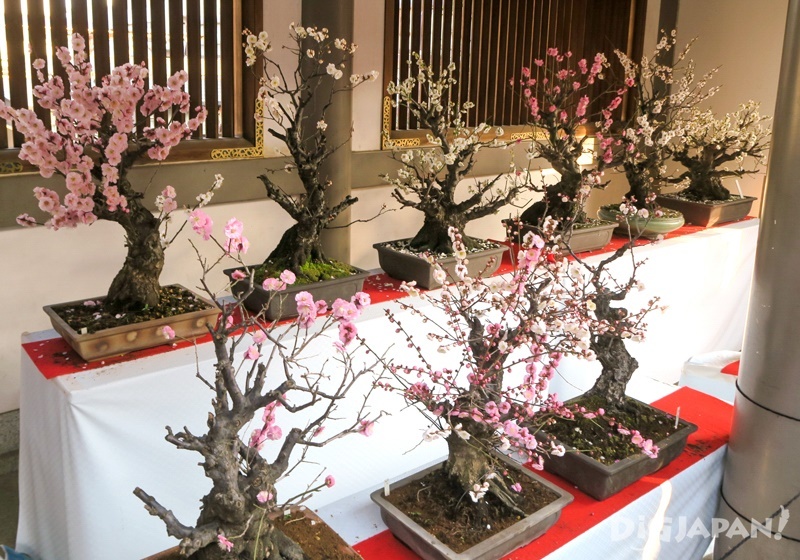
Here you'll even find plum blossoms in miniature!
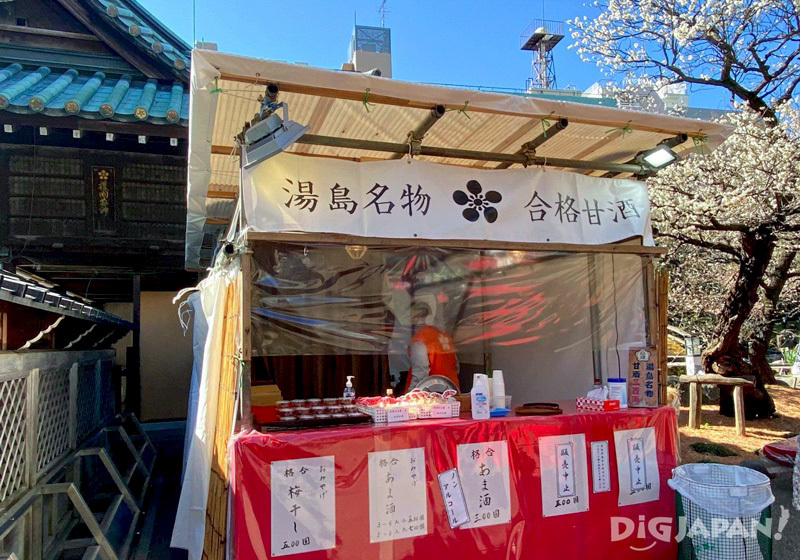
This shrine is often visited by students that pray for success in their exams. Here you can have a cup of the "exam success amazake" (a fermented rice drink) which is very popular with the students!
Information
Yushima Tenmangu (Yushima Tenjin) | 湯島天満宮(湯島天神)Address: 3-30-1 Yushima, Bunkyo-ku, Tokyo (MAP)
Access: 2 min. walk from Yushima Station on the Tokyo Metro Chiyoda Line / 5 min. walk from Ueno-Hirokoji Station on the Tokyo Metro Ginza Line / 5 min. walk from Ueno-okachimachi Station on the Toei Oedo Line / 8 min. walk from JR Okachimachi Station
Website (Japanese-only): https://www.yushimatenjin.or.jp/
3. Hanegi Park

A little off the beaten track, between the areas of Shimokitazawa and Gotokuji, Hanegi Park stands on a hill in a place called Umegaoka, literally "plum hill". The park is home to a whopping 650 ume trees of around 60 different varieties.
During the blooming season (early February to early March) the Setagaya Plum Blossom Festival is held, where you can find stalls selling plum-themed food, music performances, tea ceremony, a plant market and more. Strolling among the trees on the gentle hill on a clear winter day is priceless!
(The 2021 festival was cancelled but you can still visit the park)
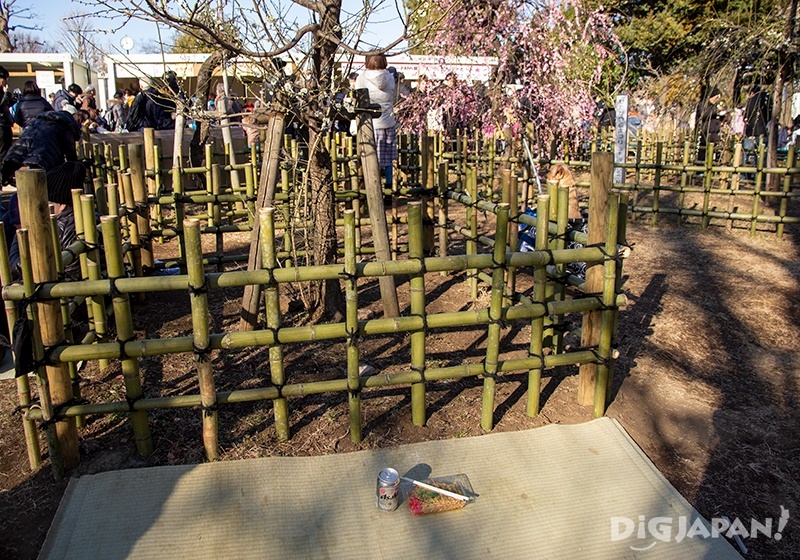
When I went to the festival back in 2017 you could rent these tatami mats to sit on.

Even in the cold winter you can't resist enjoying a drink while admiring the flowers!


Information
Hanegi Park | 羽根木公園Address: 4-38-52 Daita, Setagaya-ku, Tokyo (MAP)
Access: 5 min. walk from Umegaoka Station on the Odakyu Line / 7 min. walk from Higashi-Matsubara Station on the Keio Inokashira Line
4. Sumida River Plum Blossom Walk

Finally, a little place hidden in plain sight! This spot is inside Asakusa's Sumida Park, a pleasant green area along the Sumida River. Many come here to see the cherry blossoms, but there is actually an area of the park dedicated to plum blossoms as well. While there are not as many trees as the previous places, the backdrop of the Tokyo Skytree makes for some stunning views!

There's a nice walking path among the plum trees.

Pick your favorite color tree for a very seasonal shot of the Tokyo Skytree!
Information
Plum Blossom Walk | 梅めぐり散歩道Address: inside Sumida Park, 7-1 Asakusa, Taito-ku, Tokyo (MAP)
Access: approx. 9 min. walk from Asakusa Station on the Tokyo Metro, Toei, and Tobu lines
Bonus: Plum-Flavored Snacks and Drinks

Japanese people love to enjoy not only the sight, but also the taste of the seasons. That's why in February you'll find many plum-flavored snacks lining the supermarket shelves. The salty and sour taste of umeboshi (pickled plums) is very unique and a staple of Japanese food.
Plum-Flavored Kaki no Tane

One of the best beer snacks in Japan! Kaki no tane is a mix of tiny senbei (rice cracker) bits and peanuts. They are great plain, but depending on the season they can come in many flavors (wasabi is one of my favorites). This special variety has been seasoned with plum paste and granulated sugar, for a pleasant sweet-sour taste!
Plum-Flavored Potato Snacks

Potato snacks also come in infinite flavors in Japan. I picked up some Jagarico sticks, which have a milder taste to them, and some classic potato chips, that are stronger and taste like concentrated umeboshi!
Gulp It All Down With an Ultra-Sour Sour!

This is usually available year-round, but I included it because it's the perfect drink to go with my plum snacks! The "otokoume sour" is an intensely flavored alcoholic drink that's packed with the salty-sour taste of umeboshi. After getting used to the first few sips you'll love it! That is, if you enjoy a very sour taste.
If you're in Tokyo in February and March I hope you get to enjoy the elegant plum blossoms. Chasing these seasonal views around the city can lead you to discover new and amazing places. And don't forget to check the supermarkets or convenience stores and try a few limited-edition plum snacks!
*The above article is based on information from February 2021.
*Prices, business hours and other information in this article are subject to change.
About the Author
Laura is an Italian living and working in Tokyo. She loves exploring hidden and unknown places, taking pictures and listening to Punk Rock music. When she’s not busy doing the above, she might enjoy a craft beer or play the sanshin (an Okinawan instrument similar to a shamisen).

Liked this story? Like DiGJAPAN!
on Facebook for daily updates!
THIS ARTICLE IS BASED ON INFORMATION FROM 03 01,2021 Author:DiGJAPAN! Editorial Team













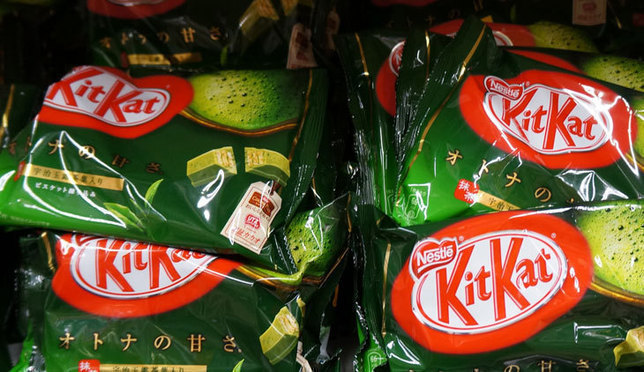


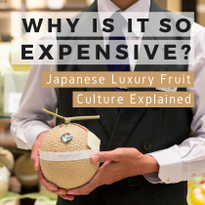





NEW COMMENT | 0 COMMENTS
Open a DiGJAPAN!
account to comment.
Open a DiGJAPAN! Account